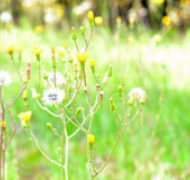Year of Plenty
Blog / Produced by The High Calling
In 2008 a young suburban family of four set out to consume everything according to four rules: local, used, homegrown, and homemade. Year of Plenty tells the story of that year and offers a reflection on the intersections of their Christian faith, their life as pastors, and their experiences at the margins of consumer culture. The book is organized around the four seasons. The following excerpt introduces Spring.
Living within the culinary confines of winter root crops, I have never been so attentive to the slightest hints of spring as I was during those first months of 2008. It was a hard winter with record snow and biting cold. Spring was taking its sweet time to arrive so in the middle of February with no sign of resurrection to be found, I took matters into my own hands. I ordered a used electric heater on eBay and put it in our small 6x8 greenhouse. I crunched my boots step-by-step through a foot of snow to fill the greenhouse with our first trays of seed starts.
In Spokane, the traditional last freeze date is May 15 and most seed packs offer instructions about starting seeds indoors a certain number of weeks before the last freeze date. Most seeds are best started six to eight weeks before this important date but I was unfazed. This year the best time to start seeds would be 14 weeks before reaching the seasonal milestone.
I thought I could sneak around the limits of the seasons; length of days, soil temperatures, hard freezes, long shadows from a low-slung sun. I attended to these realities initially only in as much as I wanted to overcome them, to contort them to my timing. My creative energies went into how to get around them and get a leg up.
But I learned that year the lesson I learn every year, only harder. These boundaries can be stretched and fudged, but they cannot be overcome. They are boundaries beyond my control, marching forward at their own mysterious pace. Efforts to fool the seasons in a particular place always, yes always, end up making us the fool.
My hydroponic farmer friend, who grows food in the climate controlled environment of a greenhouse 12 months a year, tells me that even he is bound to these seasonal boundaries. A tomato grown in August in a hydroponic greenhouse will taste just like a tomato grown outside in the soil, but in the middle of winter, when the sun is in short supply, all the lights in the world won’t make that tomato taste like it is summer fresh. He says, “You can’t fool the plants.”
I put my starts in the soil well before the last freeze date and instead of growing in the warmth of my optimism they sat shivering in the near-freezing soil. They looked up at me in their hypothermic state and asked, “Why?” Plants don’t grow just because they have water and soil. They grow in a complicated interaction of soil temperature, length of days, direct sunlight, and moisture. Without the proper mix of these factors the plants just sit, sometimes rotting or freezing, but never growing.
As the futility of my efforts to grow food set in, I began to take a different perspective. My view shifted and my attention turned to what the spring thaw offered up, instead of what it disallowed. With these new eyes to see I noticed the wonder of rhubarb bursting out of the ground, crinkled and leathery. Not far from my suffering plant starts were what gardeners call “volunteers.” Here I had been forcing my will on plants like a garden tyrant conscripting a fearful population of early season vegetables when, from every corner of the yard, there were volunteers coming forward of their own free will—cilantro, dill, chives, and dandelions.
Yes, dandelions. They are a tasty source of fresh spring greens that I’ve proven I can grow year after year. This crop is a good confidence builder for any gardener nursing his wounds from a fickle spring.
In March, when I was on dinner duty, I wandered the property and gathered a bounty of the green serrated leaves and tossed them into an early spring salad that consisted of locally sprouted mung beans from Idaho, matchstick carrots from a nearby Greenbluff farm, and dandelion leaves from cracks in our driveway. The true test was to see how the girls responded to eating “weeds.”
Noel said, “It kind of has a zing to it.”
Lily commented, “It kind of makes you perky but it’s really good.”
As we made the first transition from one season to the next, we were learning to pay keen attention to nature—and not just to scheme and contrive a way around. We were learning to see gifts where there had once only been inconveniences. We were learning that life has certain immutable rhythms and that there is unexpected joy in letting creation lead the dance.
As Jesus puts it, consider the lilies, tune into the smallest details that point to the biggest truths: Creation, Creator, Created. It’s probably no coincidence that Jesus chose among the earliest and most tender of spring wildflowers to highlight God’s glorious grace. Lilies put on the most elaborate of displays, breaking the dull drone of winter gray and announcing the certainty of the turning of the seasons. More broadly Jesus is saying consider the glorious springtime. Before you plant and harvest and “make” the world in the heat of summer, remember that the world was made and you are caught up in the drama of the making.
To borrow Noel and Lily’s words, this new attentiveness has a zing to it. It’s uncomfortable and confining, but it’s really good. It kind of makes you perky.
From Year of Plenty: One Suburban Family, Four Rules, and 365 Days of Homegrown Adventure in Pursuit of Christian Living by Craig L. Goodwin copyright © 2011 Sparkhouse Press an imprint of Augsburg Fortress, admin. Augsburg Fortress. Reproduced by permission. All rights reserved. Copies of the book may be purchased at www.augsburgfortress.org. No further reproduction allowed without the written permission of Augsburg Fortress.
Image by Patricia Hunter. Used with permission via Flickr. Craig is a High Calling member and blogs at Year of Plenty.





